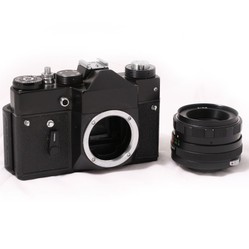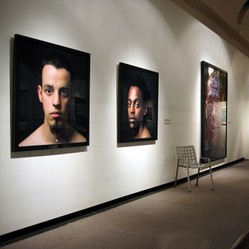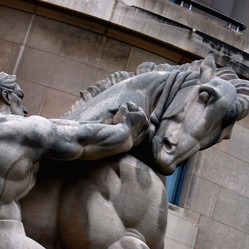
Interchangeable Lenses
by photography
The use of interchangeable lenses extends the scope of a camera; such lens systems are widely used in better-class cine and reflex cameras as well as many professional camera types
Optical Considerations
Alternative focal lengths provide a range of angles of view and image scales. They are frequently specified in relation to the normal focal length of the lens for a given picture format. This is accepted as being approximately the same as the diagonal of the picture format. Thus the diagonal of a theoretical 24 x 36 mm. format (in practice the image produced on the film is often slightly smaller) would be about 43 mm.; usually the normal focal length for a miniature camera is Lenses of shorter focal length, yielding a wider angle of view, are generally referred to as wide-angle lenses; longer focal lengths are long focus or telephoto lenses. (The two terms are used interchangeably. Strictly speaking there is a difference in the optical construction- though not in the use.)
The shorter the focal length of a lens, the smaller the scale of the image taken in, but the wider the field covered. A wide angle lens is thus useful for taking in a large view in confined quarters where it is not possible to get far enough away from the subject to include it all with a normal lens. The image usually shows an enhanced perspective effect, because the wide view tends to take in a considerable portion of foreground, and such foreground objects loom large in the picture compared to the more distant ones.
The longer the focal length, the larger the image scale but the smaller the view covered. Long-focus and tele lenses therefore are useful for showing up detail of distant objects on a large scale. The perspective in long focus views appears subdued, largely because such a view frequently takes in only a small image field of objects situated at a distance where there is less graduation in depth. In fact, the perspective depends only on the camera view point and from a given viewpoint the geometrical perspective of any portion of the image taken in by a wide-angle normal and long-focus lens is identical but the apparent perspective in viewing the print is dependent on the viewing distance.
Short focus lenses yield a considerably greater depth of field at any given subject distance and lens aperture than long focus lenses. The depth of focus, at a given relative aperture, is however the same. When related to the image scale (magnification or reduction) a depth of field, however, is also constant irrespective of the focal length. That is to say, the depth of field for a subject taken with a long-focus lens is the same as the depth for the same subject taken with a shorter focus lens at a sufficiently closer distance to reproduce the subject in the same scale on the film.
While a normal or even wide-angle lens for a given picture format can be used as a long-focus lens for a smaller format, the reverse is not practical. This is because a wide-angle lens must be designed with a suitable covering power to cover the field of the image format with which it is used. A normal lens for a given format is not usually able to cover the wider field required of a wide-angle lens for a larger format, even though both may be the same focal length.
Wide angle lenses for reflex cameras are also subject to design limitations posed by the need for an adequate back focus to clear the reflex mirror. This calls for inverted telephoto type constructions.
 | From Point & Shoot to DSLR: A Compact Guide to Transitioning to an Interchangeable-Lens Camera Easier to understand than a camera manual and shorter than a 400-page how-to book, this compact guide is designed to quickly introduce the various modes available on your DSLR s... |
 | Beyond Point-and-Shoot: Learning to Use a Digital SLR or Interchangeable-Lens Camera There are two types of new photographers: those satisfied with their low-cost point-and-shoot cameras, and those more enthusiastic photographers who recognize the limitations of... |
Convertible and Interchangeable Lenses
There are three main ways (apart from zoom lenses) of providing alternative focal lengths for a camera:
- By changing the whole lens;
- By changing part of the lens;
- By fitting lens attachments in front of the fixed lens of the camera.
Fully interchangeable lenses are invariably mounted in front of the camera shutter. With focal plane shutter cameras this presents no problem, since the shutter itself is well behind the lens. The range of focal lengths available for such a camera is usually limited only by the physical dimensions of the camera mount and by considerations of usefulness. Angles of view may range from nearly 180° to 1 or 2°, focal lengths (with for instance a 35 mm. miniature camera) from 8 or 10 mm. (fish-eye lenses) to several metres.
Practical ranges found on professional cameras often go from 20 to 1,000 mm; for amateur use about 28 to 200 mm is adequate.
With diaphragm shutter cameras the construction becomes a little more complicated. Here the interchangeable lens range needs a reasonable constant back focus to avoid vignetting if the diaphragm shutter is too far behind the rear of the lens. Focal lengths are thus more limited, but again nearly always adequate for amateur use. The limitation is given by the minimum back focus to enable the lens to fit in front of the shutter (for wide-angle lenses) and by the dimensions of the shutter (for long-focus lenses).
An alternative, with diaphragm shutters, is to change the lens together with the shutter. This requires a separate shutter for each focal length, but is frequently used with professional and technical cameras.
In a convertible lens system for alternative focal lengths part of the lens—the rear element or elements—remain fixed in the camera, while only the front units are interchanged. The different front units together with the fixed rear component then yield the alternative focal lengths. The rear unit is mostly mounted behind the shutter, a diaphragm-type built into the camera.
This particular type of interchangeable lens system is nowadays only used on a few 35 mm. miniature cameras; it is somewhat limited in the range of focal lengths available (usually in a ratio of 1 : 3), and also poses special design problems.
The design problems with convertible lenses of this kind are considerable, and both the wide angle and the tele constructions are usually considerably more complex than they would be with a fully interchangeable lens of similar focal length.
More old-fashioned types of convertible lens for field cameras consist of two components or groups of elements which can be used either singly or together to give different focal lengths.
A related design idea is the use of afocal lens attachments which fit in front of the complete (and firmly built-in) camera lens to convert the latter into a wide-angle or tele lens unit. Such conversion attachments have been produced for a number of cheaper miniature cameras, as well as for twin-lens reflexes where changing both the finder and the taking lens is not always practical. In the simpler versions they sometimes involve certain quality compromises, since it is not easy to design a camera lens so that it gives optimum performance on its own as well as in combination with the lens attachment.
Lens Changing Mounts
The commonest ways of changing lenses is by a bayonet or by a screw mount. With a screw mount the whole lens screws in and out of a fitted flange in front of the camera. Changing of screw-mounted lenses tends to be slow, but wear and tear is evenly distributed over a large area of screw thread, so that screw mounts remain reliable for a long time.
With a bayonet mount the lens can be clipped into and out of the camera by approximately a quarter turn, and is generally secured by an additional catch. Lens changing is much more rapid, but the mechanical bearing surfaces are smaller and thus subject to more intense wear. It is less easy to seat a lens absolutely firmly with a bayonet mount;
Various combined screw and bayonet mounting systems have been tried at different times in an attempt to utilize the advantages of both systems. Systems with bayonet or screw clamping and retaining rings also exist. Convertible lenses (with interchangeable front components) are almost invariably bayonet mounted; so are interchangeable lenses for cameras with a built-in diaphragm shutter.
On technical and certain other cameras where the lenses change together with the shutter, lens and shutter are usually mounted on a panel which is clamped in position on the front unit of the camera.
Afocal attachments may screw or bayonet into the front mount of the normal camera lens.
With still cameras screw and bayonet mounts exist in a variety of sizes and specifications, and the camera will usually take only the lenses of a series specially designed for it. With cine cameras there is greater uniformity through the use of standard mounts: type D for 8 mm. cameras and type C for 16 mm. cameras. These are screw mounts, in which the thread, pitch, and the flange-to-film plane distance are accurately specified.
For rapid lens changing cine cameras often carry two or three focal lengths on a lens turret. Rotation of the turret brings the alternative focal lengths into place in front of the film. Turret cine cameras are however giving way to an increasing extent to cine cameras with zoom lenses. Turret systems have also been tried with still cameras, but have not been successful owing to the great bulk of a turret with two or three lenses.
A special kind of interchangeable lens mount is the sub-assembly mount where the camera takes one or more interchangeable units consisting of a focusing mount and aperture controls. The lenses themselves then fit interchangeably into this sub-assembly mount. The advantage is less bulky interchangeable lenses, since the latter consist only of the lens unit proper without a separate focusing mount for each focal length.
You might also like
Photo CritiqueTips for Photographing SculpturesPhotographing sculptures calls for as great, if not greater, skill in the use...






 Photographic Styleon 10/14/2011
Photographic Styleon 10/14/2011
 Negative Blisters and Blemisheson 09/17/2011
Negative Blisters and Blemisheson 09/17/2011
 Photographyon 08/22/2011
Photographyon 08/22/2011
 Daguerreotypeon 08/24/2011
Daguerreotypeon 08/24/2011


Comments